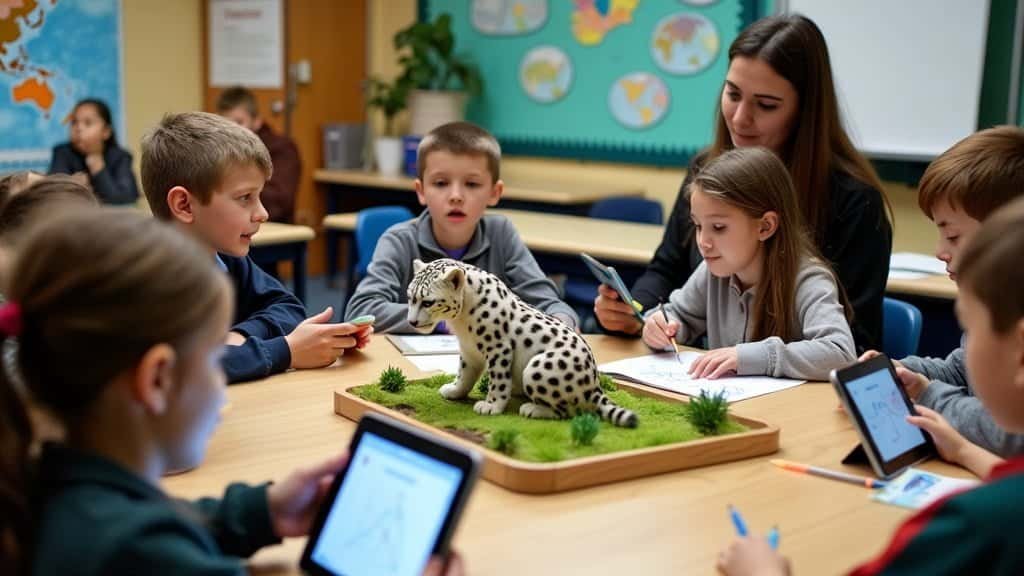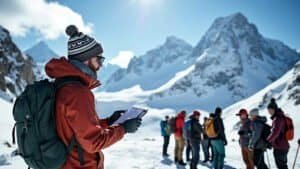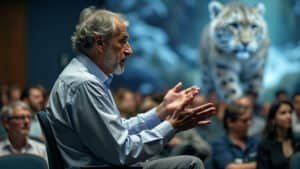Introduction
Educational programs centered around snow leopards play a crucial role in engaging students with the principles of conservation science. These programs not only introduce students to the majestic snow leopard but also integrate broader themes of environmental stewardship and biodiversity
By utilizing interactive learning methods, real-world conservation projects, and digital tools, these programs aim to foster a deep understanding of the importance of preserving endangered species
Throughout this article, we will explore how these programs use innovative educational activities, connect conservation efforts to broader environmental science, inspire student action, and address the challenges educators face in this critical area of education
Educational Activities Focused on Snow Leopards
Educational programs that focus on snow leopards employ a range of activities designed to engage students in conservation science
These activities often blend hands-on experiences with creative media and digital tools to deepen students’ understanding of snow leopards and the ecosystems they inhabit. By focusing on interactive learning, these programs strive to make conservation science accessible, interesting, and relevant to students of all ages
Interactive Learning Approaches
Interactive learning is at the heart of many educational programs about snow leopards. These approaches include activities such as virtual reality (VR) experiences that allow students to “explore” the snow leopard’s habitat in the mountains of Central Asia
Through VR, students can observe the challenges snow leopards face, such as habitat loss and climate change, providing a vivid and immersive experience that traditional textbooks cannot match
Additionally, role-playing games are used where students can assume the roles of conservationists, researchers, and local communities working together to protect snow leopards
These games simulate real-world scenarios, such as tracking snow leopards or negotiating conservation agreements, which help students develop problem-solving skills and a deeper appreciation for the complexities of wildlife conservation
Workshops where students build models of snow leopard habitats or create their own conservation plans also encourage active participation. These activities not only teach students about the biology and ecology of snow leopards but also emphasize the importance of habitat preservation and the interdependence of species within an ecosystem. By engaging students in these hands-on activities, programs aim to instill a lasting interest in conservation
Real-World Conservation Projects for Students
Involving students in real-world conservation projects is another powerful educational strategy. Programs often partner with conservation organizations to allow students to participate in ongoing snow leopard conservation efforts
This might involve students collecting data on snow leopard populations through remote camera traps or analyzing data to help researchers understand population trends and threats
Some programs also include field trips to conservation areas where students can observe wildlife and conservation efforts firsthand. These experiences provide students with a practical understanding of what it takes to protect endangered species like snow leopards
By working alongside professionals in the field, students gain insights into the challenges and rewards of conservation work, inspiring many to consider careers in environmental science
Moreover, programs that include citizen science projects enable students to contribute to global databases on snow leopard sightings and habitats. This direct involvement in conservation science not only enhances students’ scientific skills but also makes them active participants in the global effort to save snow leopards from extinction
Role of Creative Media and Digital Tools
Creative media and digital tools are increasingly used in snow leopard education programs to engage students. For example, interactive documentaries and educational films provide visually compelling stories about snow leopards and the threats they face
These media resources are often paired with classroom discussions or activities that challenge students to think critically about the content they’ve seen
Digital tools, such as apps and online platforms, also play a significant role. Educational games that simulate snow leopard conservation challenges allow students to apply their knowledge in a fun and interactive way
Additionally, digital storytelling projects where students create their own videos or blogs about snow leopards encourage them to synthesize what they’ve learned and share it with others
These tools not only make learning about snow leopards more engaging but also help students develop digital literacy skills that are increasingly important in the modern world. By integrating creative media and digital tools into their curricula, educational programs can reach a broader audience and make conservation science more accessible and appealing to students of all backgrounds
Connecting Snow Leopard Conservation to Environmental Science
Educational programs about snow leopards often extend beyond the species itself, using it as a gateway to explore broader environmental science topics. By linking snow leopard conservation to issues like ecosystem health, biodiversity, and climate change, these programs help students understand the interconnectedness of the natural world
This holistic approach not only deepens students’ knowledge of conservation science but also encourages them to think critically about the global environmental challenges we face
Linking Snow Leopard Habitats to Broader Ecosystems
Snow leopard habitats span across the rugged mountains of Central Asia, an environment that plays a crucial role in maintaining the ecological balance of the region. Educational programs emphasize how the health of these ecosystems is directly tied to the survival of snow leopards
By studying the relationship between snow leopards and their prey, such as blue sheep and ibex, students learn about predator-prey dynamics and the importance of each species within the food web
These programs often highlight how snow leopards serve as an indicator species, meaning their well-being reflects the overall health of the ecosystem. When snow leopard populations are thriving, it suggests that the ecosystem is functioning well
Conversely, declines in snow leopard numbers can signal environmental problems that may also affect other species, including humans. Through this lens, students gain a deeper appreciation for the role that snow leopards play in maintaining the biodiversity and stability of their habitats
Field studies and classroom activities may include mapping exercises where students analyze the geographic distribution of snow leopards and the ecological features of their habitats
These activities help students understand how factors like altitude, vegetation, and climate influence snow leopard populations. By making these connections, educational programs encourage students to consider the broader implications of conserving individual species like the snow leopard
Teaching Biodiversity Through Snow Leopard Studies
Biodiversity is a key concept in environmental science, and snow leopard conservation provides an excellent case study for understanding its importance. Educational programs often use snow leopards as a starting point to explore the diversity of life in the mountains of Central Asia
Students learn about the various species that share the snow leopard’s habitat, including plants, insects, and other mammals, and how these species interact within the ecosystem
These programs might include lessons on genetic diversity, explaining how the genetic variability within snow leopard populations helps them adapt to changing environments and resist diseases. This ties into broader discussions about the importance of preserving genetic diversity in all species to ensure the resilience of ecosystems in the face of environmental changes
Classroom activities might involve creating food webs or ecosystem models that illustrate the complex relationships between snow leopards and other species
Such exercises help students visualize how the loss of a single species, like the snow leopard, can have cascading effects on the entire ecosystem. By understanding these connections, students are better equipped to appreciate the importance of biodiversity conservation
Integrating Climate Change Discussions in Conservation Education
Climate change is an increasingly important topic in conservation education, and programs focused on snow leopards are no exception. The snow leopard’s high-altitude habitat is particularly vulnerable to the impacts of climate change, such as rising temperatures, melting glaciers, and shifting weather patterns
Educational programs incorporate these issues to help students understand how climate change affects both snow leopards and their broader environment
Students might study how warming temperatures are altering the distribution of snow leopard prey or how melting glaciers are reducing the availability of water in the region, which can impact both wildlife and local communities. These discussions are often paired with data analysis exercises where students examine climate data, track changes over time, and predict potential future impacts on snow leopard habitats
By linking snow leopard conservation to the broader issue of climate change, these programs encourage students to think about the global scale of environmental challenges and the need for comprehensive solutions
This approach not only enhances students’ understanding of climate science but also underscores the urgency of taking action to mitigate the effects of climate change on vulnerable species and ecosystems
Inspiring Student Action Through Conservation Programs
Educational programs about snow leopards are designed not just to inform but to inspire action. By actively engaging students in conservation efforts, these programs aim to foster a sense of responsibility and empowerment
Through a variety of initiatives, students are encouraged to apply their knowledge and passion to real-world challenges, developing skills and mindsets that will enable them to contribute meaningfully to conservation science and environmental stewardship throughout their lives
Success Stories of Student-Led Conservation Efforts
One of the most impactful ways educational programs inspire students is by highlighting success stories of student-led conservation efforts. These stories often involve students who have taken what they learned about snow leopards and applied it in innovative ways to support conservation initiatives
For instance, students might organize fundraising events to support snow leopard conservation projects, develop awareness campaigns to educate their communities, or even create social media content that reaches a global audience
In some cases, students have gone on to collaborate with professional conservationists, contributing to research projects or advocacy efforts that have a direct impact on snow leopard conservation. These success stories not only serve as powerful examples of what young people can achieve but also provide inspiration and motivation for other students to get involved
Programs may feature these stories in their curricula, showing students that their efforts, no matter how small, can make a significant difference in the fight to protect endangered species like the snow leopard
How Programs Encourage Lifelong Environmental Stewardship
Beyond immediate actions, educational programs about snow leopards aim to cultivate a lifelong commitment to environmental stewardship. This is achieved by fostering a deep connection between students and the natural world, particularly through direct experiences with wildlife and nature
Whether through virtual experiences, field trips, or community projects, these programs provide students with opportunities to witness the beauty and complexity of ecosystems firsthand, which can be profoundly impactful
Programs often emphasize the idea that conservation is an ongoing effort that requires sustained attention and action. By instilling values such as responsibility, empathy, and perseverance, these programs prepare students to continue their conservation efforts long after their formal education has ended
This might involve pursuing careers in environmental science, participating in volunteer conservation work, or simply making environmentally conscious choices in their daily lives
Educators play a key role in this process by acting as mentors and role models, demonstrating how one can live in harmony with nature and contribute to the greater good. Through their guidance, students learn that conservation is not just a one-time effort but a lifelong journey that can bring personal fulfillment and contribute to the well-being of the planet
Measuring the Impact of Conservation Education on Students
To ensure that educational programs are effectively inspiring student action, it is essential to measure their impact
Various methods are used to assess how well these programs are achieving their goals, including surveys, interviews, and case studies. These assessments often focus on changes in students’ knowledge, attitudes, and behaviors related to conservation
For example, pre- and post-program surveys might measure students’ understanding of snow leopard conservation, their willingness to engage in conservation activities, and their overall interest in environmental science. Interviews with students can provide deeper insights into how the program has influenced their perspectives and future aspirations
Some programs also track the long-term outcomes of their participants, following up to see whether students continue to be involved in conservation efforts after completing the program. This might include tracking alumni who pursue degrees in environmental science or those who remain active in community conservation projects
By analyzing these data, educators can refine their programs to better meet the needs of their students and ensure that they are effectively fostering a new generation of conservationists
Challenges and Opportunities in Conservation Education
Teaching about snow leopard conservation presents both challenges and opportunities for educators. While the subject matter is engaging and critically important, it also requires overcoming several obstacles, such as resource limitations, varying levels of student interest, and the complexities of conservation science
At the same time, these challenges offer opportunities for innovation in educational approaches and the formation of strategic partnerships that enhance the effectiveness of conservation education
Overcoming Obstacles in Teaching Conservation Science
One of the primary challenges in teaching conservation science, especially concerning snow leopards, is the complexity of the subject matter. Snow leopards inhabit remote and rugged areas, and their conservation involves understanding intricate ecological, social, and political factors. This complexity can be difficult to convey to students, particularly younger audiences or those with limited background knowledge in science
To address this challenge, educators often simplify concepts without losing the essence of the subject. This can be achieved through storytelling, where complex scientific ideas are presented in the context of engaging narratives about snow leopards
For example, educators might frame lessons around a “day in the life” of a snow leopard, using this narrative to introduce topics such as predator-prey dynamics, habitat needs, and the impacts of human activities on wildlife
Resource limitations are another significant challenge, particularly in schools with tight budgets or those located far from natural habitats. Educators may lack access to the materials, field trips, or technology needed to provide a fully immersive learning experience
In response, many programs have developed online resources and virtual experiences that bring the world of snow leopards into the classroom at a fraction of the cost. Virtual reality experiences, documentaries, and interactive websites are increasingly used to overcome geographic and financial barriers
Varying levels of student interest and engagement also pose a challenge. Not all students may initially be interested in conservation or wildlife, making it important for educators to connect the subject to students’ lives in meaningful ways
For instance, programs might link snow leopard conservation to broader environmental issues that students care about, such as climate change or endangered species. By showing how these topics are interconnected, educators can spark interest and encourage deeper engagement
Leveraging Partnerships to Enhance Educational Programs
Partnerships are a crucial element in overcoming the challenges of conservation education and enhancing the overall impact of these programs. Collaborations between schools, conservation organizations, zoos, and research institutions can provide valuable resources and expertise that would otherwise be unavailable to educators
For example, conservation organizations may offer guest speakers, field trips, and access to real-time data on snow leopard populations, enriching the educational experience
Zoos and wildlife centers can provide firsthand encounters with animals, allowing students to learn about snow leopards and other species directly from experts. These partnerships not only provide additional educational content but also expose students to potential career paths in conservation science
Moreover, partnerships with technology companies and digital media creators can help develop and distribute innovative educational tools. For instance, collaboration with app developers can result in educational games or interactive platforms that make learning about snow leopards more engaging and accessible. These tools can be particularly effective in reaching a wider audience, including students in remote or underserved areas
These partnerships also offer opportunities for students to engage in citizen science projects, where they can contribute to real-world research on snow leopards
Such projects allow students to apply what they have learned in a practical setting, enhancing their understanding of conservation while contributing valuable data to ongoing research efforts. This not only reinforces learning but also fosters a sense of contribution and achievement among students
Future Directions in Snow Leopard Conservation Education
Looking ahead, the field of snow leopard conservation education is poised for growth and innovation. One promising direction is the increased integration of technology into educational programs. As digital tools become more sophisticated, they offer new ways to engage students and make conservation science more accessible
For example, advancements in virtual reality could allow students to participate in simulated fieldwork, experiencing what it’s like to track snow leopards in their natural habitat without leaving the classroom
Another future direction is the expansion of global networks that connect students, educators, and conservationists from different countries. Snow leopards are found across several nations in Central Asia, and international collaboration is key to their conservation
Educational programs that foster cross-cultural exchanges can help students understand the global nature of conservation challenges and the need for international cooperation. These networks can facilitate the sharing of resources, ideas, and best practices, making conservation education more effective and impactful
Additionally, there is growing recognition of the importance of incorporating indigenous knowledge and practices into conservation education. Indigenous communities in snow leopard habitats have coexisted with these animals for centuries, and their traditional knowledge can offer valuable insights into sustainable conservation practices
Educational programs that integrate this knowledge not only enrich the curriculum but also promote respect for cultural diversity and the role of indigenous peoples in conservation
As these trends continue to evolve, snow leopard conservation education will likely become more comprehensive, inclusive, and engaging, equipping the next generation with the tools and knowledge needed to tackle the complex challenges of wildlife conservation
Conclusion
Educational programs about snow leopards are powerful tools for engaging students in conservation science. By incorporating interactive learning activities, real-world conservation projects, and digital tools, these programs make the complex subject of conservation accessible and relevant to students
They connect snow leopard conservation to broader environmental science topics, helping students understand the intricate relationships within ecosystems and the impacts of climate change. Moreover, these programs inspire students to take action, fostering a lifelong commitment to environmental stewardship
While challenges such as resource limitations and varying student interest exist, they also present opportunities for innovation and partnership. As these programs continue to evolve, they will play an increasingly vital role in shaping the next generation of conservationists, ensuring that efforts to protect species like the snow leopard are sustained well into the future







